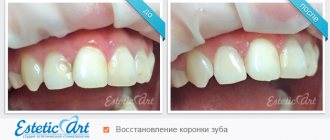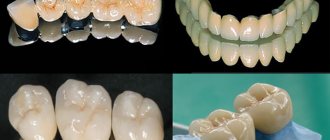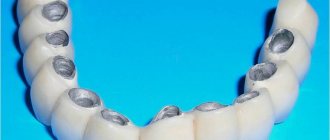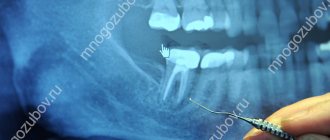Features of lower wisdom tooth removal
“Eights” on the lower jaw appear by the age of 20-25, when the main row of teeth is already formed and fully performs its functions. Therefore, the process of “growing” extreme molars is often not very pleasant and is accompanied by various difficulties, ranging from slight discomfort to serious destructive processes in the jaw. In this case, dentists are guided by the principle “seven troubles - one answer”: no matter what problems a wisdom tooth brings, there is only one way to get rid of them - removal.
Indications for surgery
So when is it necessary to remove a wisdom tooth in the lower jaw? In most cases, indications for surgery are related to certain pathologies of the lower “eight”.
- The wisdom tooth erupted incorrectly
- that is, not straight up, but with a deviation, at an angle to the jaw and neighboring teeth. The slope of the figure eight is:
- distal
- when the “eight” is tilted back, away from the “seven”. In this case, there is a risk of injury to the gums and damage to the roots of the adjacent tooth; - medial
- when the “eight”, on the contrary, is inclined towards the adjacent tooth. This increases the likelihood of damage to the crown part of the “seven” and the development of caries on both teeth; - buccal
- in this case, the wisdom tooth is turned towards the cheek and constantly touches the mucous membrane, causing irritation and hardening of the tissues. This condition can eventually lead to the formation - tumors on the mucosa.
- lingual
- when the tooth is tilted inward, it touches the tongue and damages it, making it difficult to eat and communicate.
- The wisdom tooth has erupted partially or not at all
- dentists call this condition partial or complete retention.
- With complete retention,
the molar does not come to the surface, remaining under the gum, inside the jaw. An impacted tooth may not show itself in any way - in this case, only regular treatment is indicated for control. However, in some cases, a “hidden” molar can cause a lot of problems for the patient, especially if it is located horizontally rather than vertically in the jaw. A lying tooth can damage blood vessels, destroy the jaw bone, provoke inflammation and suppuration under the gum, be very painful, lead to a shift in the dentition, and even cause the appearance of a cancerous tumor. In this case, the patient must have the lower “eight” removed. - With incomplete retention,
the tooth comes to the surface only partially, and this also poses a danger to the patient. A semi-retinated tooth injures the gums, damages the enamel of the neighboring tooth, makes it difficult to access the “seven” for hygiene procedures, and provokes the development of caries. Removing it solves all these problems.
- A wisdom tooth interferes with the normal functioning of the maxillofacial apparatus.
Even if the “eight” erupts smoothly, does not cause inflammation and does not injure soft tissues, over time it can still complicate the patient’s life.
- The appearance of caries.
Due to the difficulty of access, it is not always possible to properly clean the distal molar with a toothbrush. The accumulation of bacteria and food debris leads to caries, which can spread to neighboring teeth. In this case, removal of the lower wisdom tooth is a prerequisite for maintaining the health of the entire oral cavity. - Crowding and displacement of teeth.
Occurs if the volume of the jaw is small and the new molar becomes cramped in the dentition. In this case, the “figure eight” can provoke a shift in the dentition, twisting of the teeth, and malocclusion. After removal everything returns to normal.
Recovery period
After removal, the doctor must examine the resulting hole to ensure there are no fragments of dental tissue. Attention is also paid to the condition of the wound - heavy bleeding, as a rule, does not develop, but there are exceptions. Recommendations for patients:
- You can eat and drink only after 2 hours;
- for several days (until the wound is completely healed), avoid eating too hot/cold food and liquids - find the “golden mean”;
- you can rinse your mouth with a solution of regular baking soda;
- Carry out oral hygiene very carefully and avoid touching the wound surface with a toothbrush.
Tooth extraction, with a professional approach to the procedure, does not pose any danger and is considered a normal dental practice.
When is it better not to remove a wisdom tooth?
It seems that removing the lower wisdom tooth is the best solution to all problems, but this is not always true. In many patients, the eruption of “eights” occurs without complications, and in the future these teeth do not cause inconvenience, so there is no need for surgery. Also, you should not pull out your lower wisdom tooth if:
- dental prosthetics are planned and the third molar can become a support for a bridge;
- "seven" is missing. In this case, the wisdom tooth will take its place;
- caries affects only the upper part of the wisdom tooth. Then, instead of a traumatic removal operation, you can perform a regular filling, the price of which will be lower.
Relative contraindications to wisdom tooth removal are:
- infectious and inflammatory processes affecting the oral cavity
- for example, periodontal disease. In this case, you first need to stop the inflammation and take a course of antibiotics, and only then proceed to remove the molar; - respiratory diseases
- influenza, ARVI. They can provoke postoperative complications; - pregnancy and breastfeeding;
- cardiovascular diseases
in the acute stage.
Advantages of treatment at Aurora
Removing the lower wisdom tooth is a complex procedure that requires high specialist competence. Due to the inconvenient location and improper growth of the last molar, neighboring teeth suffer. Highly qualified specialists of our center easily and quickly carry out complex operations of this level. In addition, Aurora dentistry has other important advantages over its competitors:
- the possibility of receiving installments from Pochtabank or Renaissance Credit;
- individual approach;
- work on weekends, including for residents of the region by appointment;
- The doctor is assisted by an assistant, which allows him to carry out manipulations 2 times faster;
- modern, 100% high quality, imported materials.
Our dentistry offers the following promotions for the removal of the lower wisdom tooth:
- If you found out about us through 2GIS, we provide 5% on services;
- 10% discount on your birthday and the next 3 days
- For pensioners there is a “Golden Watch” promotion - a 10% discount on tooth extraction from 9-00 to 11-00
If you need complex and long-term dental treatment in Blagoveshchensk, we have an individual discount policy and a flexible payment schedule
To make an appointment, just call. On the appointed day, the doctor will see the patient and tell him how the lower wisdom tooth will be removed without pain after the procedure and fear.
Differences between figure eight removal on the lower and upper jaws
Removing a third molar in the lower jaw is considered a more complex procedure than removing a wisdom tooth in the upper jaw for a number of reasons.
- Access to the lower molars is more difficult than to the upper ones.
- The lower jaw bone is more massive and dense, it holds the tooth more firmly.
- The pressure on the teeth of the lower jaw is greater than on the upper teeth, so the roots of the lower molars are more developed. In addition, due to improper growth, they can be curved or misaligned.
- It is easier to perform local anesthesia from above, and anesthesia from the bottom often involves the muscles of the face, tongue, throat and ears.
All this makes the procedure for removing the 8th tooth from below a difficult task. If the upper molars in most cases can be easily rocked and pulled out with special forceps, then the lower molars often have to be removed in parts, cutting with a drill.
Easy removal
If the wisdom tooth has erupted correctly, grows evenly and has straight, untwisted roots, then there is every chance of getting by with a simple operation, which is carried out in 4 stages.
- Diagnostics
, including examination and x-ray, allows the doctor to get a more accurate idea of the upcoming operation. - Anesthesia.
Generally, local anesthesia is used for simple wisdom teeth removal. - Tooth extraction.
The doctor applies forceps, gently rocks the tooth and removes it using a special tool - an elevator. If fragments of roots remain in the hole, they are also carefully removed. - Treatment of the hole and suturing of the gums.
Antiseptic and anti-inflammatory solutions are used. In some cases, stitches are placed to protect the wound from bacteria, and the patient is sent back for rehabilitation. As reviews show, in the case of simple removal it takes very little time.
Complex removal of the lower wisdom tooth
Impacted, semi-impacted, horizontal teeth, as well as teeth with curved, twisted, branched roots, are much more difficult to remove. Preparation for such an operation is similar to uncomplicated cases (although general anesthesia is sometimes used), but the extraction of the tooth itself requires additional effort from the doctor. Almost always you have to resort to cutting the gums, and the tooth is cut with a drill and removed in parts. Then the gum is sutured. In general, the volume of intervention during complex removal of an impacted wisdom tooth is always greater than during simple removal.
Is it painful to remove a lower wisdom tooth?
The question worries everyone who is planning to get rid of the “eights,” especially if the case is complex. Patients’ concerns are understandable: after all, wisdom tooth removal is a full-fledged operation. However, there is no need to be afraid of pain. During the process of cutting the gums, sawing and extracting the molar, the patient may feel pressure, vibration or stretching, but nothing more: modern anesthetics make the process absolutely painless.
After the anesthesia wears off, pain may become more intense, so the doctor will definitely prescribe painkillers to make the recovery period as comfortable as possible. If healing proceeds without complications, they will have to be taken for 2 to 5 days, depending on the extent of the intervention. As the soft tissues recover, the pain gradually becomes more tolerable and soon disappears completely.
Dental restoration with veneers
For small chips, cracks, stains, or darkening on the front teeth, we will solve these problems by installing one or more veneers. These are thin (up to 0.8 millimeters) non-removable ceramic structures, which are made in the laboratory using CAD/CAM equipment and firmly fixed to the outer surface of the teeth. After veneering, you will get rid of defects, your smile will look healthy and attractive.
You can find out how much it costs to restore your front teeth in your case from the doctors at the Lucky Smile clinic. After the examination, we will offer treatment options and together with you we will choose the best one for your budget.
You may also be interested in getting temporary crowns.
Consequences and possible complications
It is necessary to separate the consequences of the operation and complications after it. All patients experience consequences to one degree or another - this is a normal reaction of the body to intervention, but it is better to avoid complications.
Consequences include:
- painful sensations;
- bleeding gums within 3-5 hours after surgery;
- swelling of the gums, cheeks;
- bruises on the face in the area of intervention;
- rise in temperature.
Complications may be as follows:
- prolonged bleeding
- due to the fact that the tissues around the lower “eights” are saturated with blood vessels. In this case, the doctor may apply additional hemostatic measures; - alveolitis
- inflammation of the wound surface associated with infection in the hole. It is characterized by the following symptoms: fever, bad breath, swelling, pain. Requires additional wound treatment and antibiotics; - paresthesia
- loss of facial sensation. Usually the lips, cheeks, and tongue suffer - they do not feel touch, do not distinguish between hot and cold. Loss of sensitivity is associated with damage to the facial nerve and may go away on its own within 1-2 weeks, but in some cases requires additional therapy; - dislocation of the mandibular joint
is a rare but possible complication associated with excessive efforts made by the surgeon to extract the tooth. The dislocation can be corrected immediately.
Attention!!!
Removing a problematic lower molar is a full-fledged operation, so special attention should be paid to the recovery period. It is necessary to strictly follow the doctor’s recommendations and carefully care for the oral cavity, then the likelihood of developing the complications described in the previous section will be minimal. Standard assignments include:
- taking painkillers and antihistamines
- antibacterial rinses
- cold compresses on the cheek in the area of intervention (reduce hematomas and reduce the risk of re-bleeding)
- prohibition on eating during the first hours after surgery
- ban on smoking, drinking alcohol, physical activity
- ban on visiting the sauna and swimming pool, taking hot baths
If the doctor did not make mistakes during the operation, and the patient does not violate the recovery regime, then very soon there will be no trace of unpleasant sensations.
Time and prices for the procedure
This complex operation takes about an hour. The duration of the procedure depends on the complexity of the figure eight position and the degree of neglect.
The consultation is free of charge. The final cost can be found out after consulting a specialist.
| Name of service | Unit | Price |
| Primary appointment (examination, consultation) with a dental surgeon | units | 0 |
| Repeated appointment (examination, consultation) with a dental surgeon | units | 500 |
| Complex tooth extraction with root separation | units | 7000 |
| Removal of periodontitis tooth | units | 2000 |
| Removal of a permanent tooth | units | 4000 |
| Flap surgery in the oral cavity in the area of the 1st tooth | units | 2000 |
| Flap surgery in the oral cavity on periodontal tissues (convet flap displacement) | units | 6000 |
| Removing stitches | units | 200 |
| Suturing the oral mucosa | units | 500 |
| The operation of removing an impacted, dystopic or supernumerary tooth | units | 8000 |
| Stopping alveolar bleeding without suturing using hemostatic materials | units | 500 |
A detailed price list can be found on the website.










